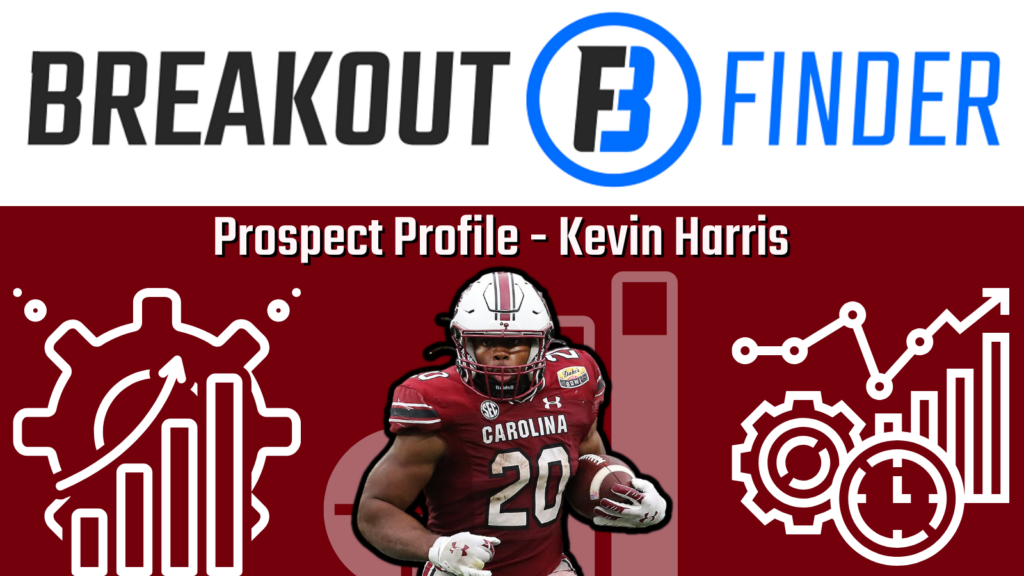
Kevin Harris pulled through for us, participating in the 40-yard dash and agility drills at South Carolina’s Pro Day. As a result, we have a full athletic profile to work from:
The 40-time is a bit disappointing given that Harris has reported game speed near the 22 miles per hour threshold. But it’s certainly within the realm of reasonable for NFL running backs. We’ve seen lots of 4.6 guys succeed in the past.
Harris was decent and bad in the short shuttle and three-cone drills, respectively. And we probably shouldn’t view lateral agility as one of his meal-ticket traits. Explosiveness is a different story. His performance in the jumps produces a Burst Score in the 89th-percentile.
He’s a good-but-not-great athlete. Given the above testing results and his stout frame, the following historical prospects are most similar to Harris from a purely physical standpoint:
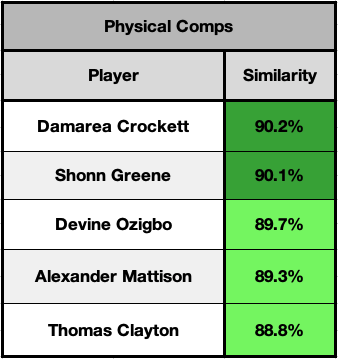
Harris’ closest athletic comp is actually Chris Carson, who comes in just behind James Robinson as the eight-closest physical comp. Even beyond those guys, Alexander Mattison and Shonn Greene have both been quality NFL backs. Greene has two 1,000-yard rushing seasons to his name. Most of the players on this list are JAGs. But Harris’ physical profile certainly doesn’t disqualify him from being a successful runner at the next level.
Production Profile
Kevin Harris was one of the best underclassman running backs we’ve ever seen.
In the SEC (albeit on fairly weak South Carolina teams), he posted an 80th-percentile Dominator Rating as a true freshman in the four games in which he was active that season. He then followed that up with the third-highest sophomore Dominator Rating among eventual NFL running backs since at least 2005. The only guys above him on that list are Donnel Pumphrey and C.J. Anderson. Both did their damage in the Mountain West Conference and at the community college level, respectively.
Harris suffered a back injury near the end of that 2020 season, and spent the subsequent offseason recovering from surgery. His production as a junior took a dip as a result. Still, Harris is a guy with a sub-19-year old breakout and a truly excellent season on his resumé.
Given the seasonal Dominator Ratings he posted and the quality of teams he played for, the following historical prospects had the most similar college production profiles:
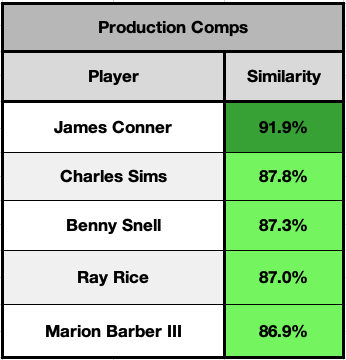
The James Conner career arc is a great comparison point for Harris. Both of them were solid producers on mediocre Power-5 teams as freshman before blowing up as sophomores. Then, as Harris’ ensuing production was hampered by injury, Conner was diagnosed with cancer and missed his junior season before posting relatively subdued numbers as a fourth-year guy.
Rushing Efficiency
I wrote a full breakdown on Kevin Harris‘ rushing efficiency profile that can be found here. The following is an overview of his performance on the ground:
Harris’ team-relative efficiency metrics are not especially impressive at first glance. But I think the context surrounding those numbers is important.
More Context
Historical data indicates that an NFL-quality runner with the same volume that Kevin Harris had and playing with the same level of teammates that Harris played with should outdo those teammates by 0.36 yards per carry. His YPC+ mark is just 0.46, but it’s higher than expectation.
Also relevant is the fact that defenses were stacking the box against him to a level not seen by any other running back in my database. The only player with a higher Box Count+ is Hawaii’s Calvin Turner, who’s really more of a gadgety wide receiver.
Given those heavy fronts, Harris was actually very efficient relative to his teammates. His Box-Adjusted Efficiency Rating is impressive, but his Relative Success Rate is excellent. It’s below only Kenneth Walker and Dameon Pierce among 2022 backs. Adding a Breakaway Conversion Rate suggesting upper-percentile ability in the open field, Harris was both consistent and dynamic in college.
An area where he does not excel is as a tackle-breaker. That’s not a great thing. But given the thoughts I shared here, I don’t necessarily view it as a huge negative.
Considering his physical profile in combination with the above metrics, the most similar historical prospects to Harris from a “pure runner” perspective are:
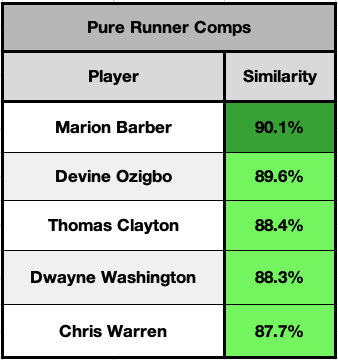
We don’t have broken tackle data for Marion Barber. But he was similarly built, similarly explosive, and similarly efficient to Harris while also playing with talented teammates at Minnesota. It’s not my favorite stylistic comp though, because I’d probably go with James Conner there. Conner finds himself as the 20th player on this list (at 85.5-percent similar) due to explosiveness that is far worse than Harris’. But as two big dudes with subpar speed, they also posted strikingly similar efficiency numbers:
Receiving Chops
Kevin Harris has above-average Target Share numbers and raw receptions totals. But I think he caps out as a non-liability in the passing game as an NFL player.
While relatively involved as a pass-catcher, he wasn’t used dynamically and wasn’t efficient on the basic targets he received. He may have the worst hands in the class. Even his True Catch Rate, which looks only at catchable targets, is the lowest among all 2022 runners. That’s not a great sign when the passes he’s being thrown are almost exclusively swing passes, screens, and checkdowns behind the line of scrimmage. At this point in his development, he’s not a three-down back.
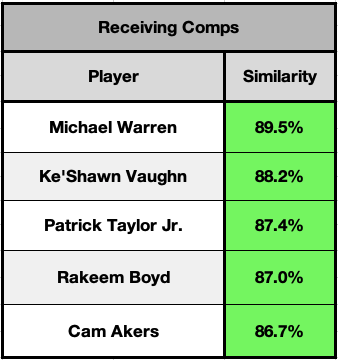
Go check three-down weapon Cam Akers‘ college receiving numbers and tell me they’re materially better than those of these other guys. Like the rest of these JAGs, Harris should not be expected to contribute heavily as a receiver at the next level.
Overall Profile
Kevin Harris‘ NFL potential probably hinges on the sort of recovery he’s made from the back injury he suffered in 2020. Given that he came back and was both healthy and reasonably effective in 2021, I’m optimistic about the chances that he regains the form we saw early on his career.
If he’s that guy, he’s a top-five runner in this class. With a near-elite combination of consistency and big play production (the average between the percentile ranks of his Relative Success Rate and Breakaway Conversion Rate is the ninth-highest in my database and the fourth-highest in the 2022 class), he’s a full-package ballcarrier with workhorse size and high-end explosiveness.
The historical prospects whose complete profiles were most like Harris’ are the following:
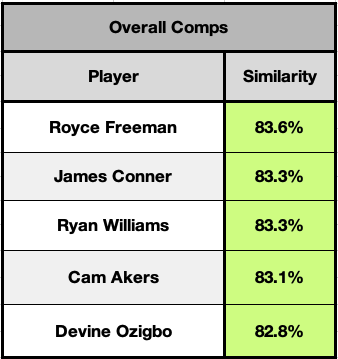
Would you run it back with a slightly slower Royce Freeman redux? Would your ears perk up for a more explosive James Conner? Would a healthy, 220-pound Ryan Williams be an appealing prospect? Would Cam Akers be an intriguing option in the third round of rookie drafts if he ran a 4.60? Would an alternate dimension version of Devine Ozigbo with precocious production be an interesting player?
If you answered “yes” to any of the above questions, you have to be in on Harris at cost. The drawbacks in his profile are that he doesn’t offer much in the passing game and could just be a diminished player given his injury history. But you likely don’t need to spend up much to find out what’s what.
Last Word
Kevin Harris is going pretty under-the-radar in this running back class, and I’d imagine you’ll be able to snag him with a third-round rookie pick. He was my pre-Combine RB2, and while he hasn’t done much to be knocked off that spot. The weigh-ins of both Kenneth Walker and Rachaad White alleviated my concerns about them enough to drop Harris behind them. After those guys, he’s as appealing an option as any guy in this class.







